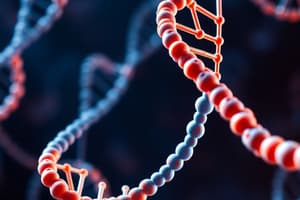Podcast
Questions and Answers
What type of bond involves the sharing of two pairs of electrons?
What type of bond involves the sharing of two pairs of electrons?
- Hydrogen bond
- Single covalent bond
- Triple covalent bond (correct)
- Ionic bond
Inorganic compounds generally contain how many carbons?
Inorganic compounds generally contain how many carbons?
- 2 or more
- 4 or more
- 0 or 1 (correct)
- 3 or more
What type of compound regulates the pH of a solution by removing or replacing H+ ions?
What type of compound regulates the pH of a solution by removing or replacing H+ ions?
- Buffers (correct)
- Electrolytes
- Proteins
- Organic compounds
Which type of bonds occur between molecules and affect properties like surface tension in water?
Which type of bonds occur between molecules and affect properties like surface tension in water?
What do proteins consist of?
What do proteins consist of?
Which type of compound is soluble and can conduct an electric current due to its ions?
Which type of compound is soluble and can conduct an electric current due to its ions?
What is the main difference between DNA and RNA?
What is the main difference between DNA and RNA?
Which type of bond involves the sharing of electrons between atoms to complete their outer energy shells?
Which type of bond involves the sharing of electrons between atoms to complete their outer energy shells?
How do isotopes of an element differ from each other?
How do isotopes of an element differ from each other?
What type of bond is formed by the attraction between a positively charged atom and a negatively charged atom?
What type of bond is formed by the attraction between a positively charged atom and a negatively charged atom?
What is the main function of hydrogen bonds in molecules?
What is the main function of hydrogen bonds in molecules?
Which subatomic particles have no charge and a mass similar to that of protons?
Which subatomic particles have no charge and a mass similar to that of protons?
Flashcards are hidden until you start studying
Study Notes
Nucleic Acids
- Thymine is only found in DNA, while Uracil is only found in RNA.
- DNA is double-stranded, whereas RNA is single-stranded.
Atomic Structure
- Protons have a positive charge and are found in the nucleus of an atom.
- Neutrons have no charge and are found in the nucleus of an atom, with a similar mass to protons.
- Electrons are small particles with a negative charge, found in the orbital "cloud" outside the nucleus.
- Atomic number is the number of protons in an atom.
- Atomic mass is the number of protons and neutrons in an atom.
Isotopes
- Isotopes are different atoms of the same element, with the same number of protons and electrons, but a different number of neutrons.
- Isotopes have identical chemical characteristics but different atomic masses.
- Examples of isotopes include Carbon-12, Carbon-13, and Carbon-14.
Chemical Bonds
- Chemical bonds hold atoms together to form molecules and compounds.
- Covalent bonds are formed by sharing electrons between atoms.
- Ionic bonds are formed by the transfer of electrons, resulting in attraction between a positively charged and negatively charged atom.
- Hydrogen bonds are weak bonds between a hydrogen atom and an oxygen or nitrogen atom.
Covalent Bonds
- Covalent bonds involve sharing electrons to complete outer energy shells.
- Nonpolar covalent bonds involve equal sharing of electrons between atoms.
- Polar covalent bonds involve unequal sharing of electrons between atoms.
- Examples of covalent bonds include single, double, and triple covalent bonds.
Hydrogen Bonds
- Hydrogen bonds occur between molecules and alter the shapes and properties of molecules.
- Examples include surface tension of water.
Ionic Bonds
- Ionic bonds form between charged atoms (ions) with opposite charges.
- Ions are atoms with either a positive charge (cations) or a negative charge (anions).
- Ionic bonds form due to attraction between positive and negative charges.
Compounds
- Inorganic compounds have 0 or 1 carbon atoms.
- Organic compounds contain 2 or more carbon atoms.
- Electrolytes are soluble inorganic molecules, like NaCl, whose + and - ions conduct an electric current.
- Buffers are compounds that regulate the pH of a solution by removing or replacing H+ ions.
Proteins
- Proteins are composed of chains of amino acid monomers.
- Amino acids form amino acid chains known as peptides.
Studying That Suits You
Use AI to generate personalized quizzes and flashcards to suit your learning preferences.




